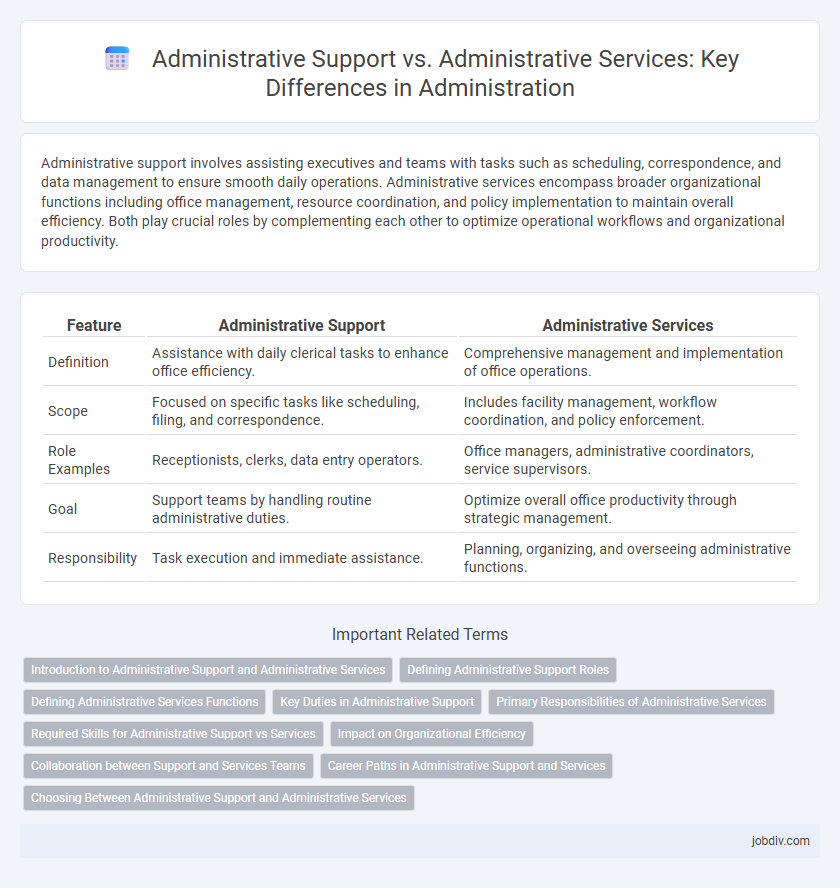Administrative support involves assisting executives and teams with tasks such as scheduling, correspondence, and data management to ensure smooth daily operations. Administrative services encompass broader organizational functions including office management, resource coordination, and policy implementation to maintain overall efficiency. Both play crucial roles by complementing each other to optimize operational workflows and organizational productivity.
Table of Comparison
| Feature | Administrative Support | Administrative Services |
|---|---|---|
| Definition | Assistance with daily clerical tasks to enhance office efficiency. | Comprehensive management and implementation of office operations. |
| Scope | Focused on specific tasks like scheduling, filing, and correspondence. | Includes facility management, workflow coordination, and policy enforcement. |
| Role Examples | Receptionists, clerks, data entry operators. | Office managers, administrative coordinators, service supervisors. |
| Goal | Support teams by handling routine administrative duties. | Optimize overall office productivity through strategic management. |
| Responsibility | Task execution and immediate assistance. | Planning, organizing, and overseeing administrative functions. |
Introduction to Administrative Support and Administrative Services
Administrative support encompasses tasks that assist daily operations, such as managing correspondence, scheduling appointments, and maintaining records to ensure organizational efficiency. Administrative services refer to a broader scope, including strategic planning, resource management, and policy implementation that sustain overall business functions. Both elements are essential in streamlining workflows and enhancing operational productivity.
Defining Administrative Support Roles
Administrative support roles involve providing clerical assistance, managing schedules, handling correspondence, and organizing office tasks to ensure smooth daily operations. These roles focus on directly aiding executives, teams, and departments with routine organizational processes. Conversely, administrative services encompass broader managerial functions, including policy implementation, resource allocation, and overseeing office systems.
Defining Administrative Services Functions
Administrative services functions encompass a broad range of tasks designed to ensure organizational efficiency, including office management, record keeping, and facility coordination. These functions support core business operations by managing communications, scheduling, and resource allocation. Defining administrative services involves outlining responsibilities that streamline workflows and facilitate seamless internal processes.
Key Duties in Administrative Support
Key duties in administrative support include managing schedules, organizing meetings, and handling correspondence to ensure seamless office operations. Administrative support professionals also maintain records, prepare reports, and assist with data entry, contributing to efficient workflow management. These tasks differ from broader administrative services, which may encompass facility management and policy implementation.
Primary Responsibilities of Administrative Services
Administrative Services primarily encompass managing organizational operations such as facility maintenance, procurement, and compliance with regulatory requirements. These services ensure efficient workplace functionality, including recordkeeping, security coordination, and office resource management. Central to administrative services is streamlining processes to support overarching business objectives and operational continuity.
Required Skills for Administrative Support vs Services
Administrative support requires proficiency in time management, communication, and basic technological tools such as Microsoft Office and email platforms. Administrative services demand advanced skills including project management, data analysis, and knowledge of organizational processes to enhance operational efficiency. Both roles prioritize problem-solving and multitasking, but administrative services emphasize strategic planning and resource coordination.
Impact on Organizational Efficiency
Administrative support streamlines routine tasks such as scheduling, correspondence, and data management, significantly reducing operational bottlenecks and allowing staff to focus on core responsibilities. Administrative services encompass broader functions including policy implementation, resource allocation, and compliance monitoring, which establish a structured framework for consistent organizational performance. Together, these components enhance overall efficiency by optimizing workflow coordination and ensuring adherence to organizational standards.
Collaboration between Support and Services Teams
Effective collaboration between administrative support and administrative services teams enhances organizational efficiency by streamlining communication and coordinating tasks. Administrative support staff handle day-to-day operations such as scheduling and correspondence, while administrative services teams manage broader functions including facilities management and policy implementation. Integrating workflows between these teams ensures seamless service delivery, optimal resource utilization, and improved internal stakeholder satisfaction.
Career Paths in Administrative Support and Services
Career paths in administrative support often involve roles such as administrative assistants, office coordinators, and executive assistants, emphasizing direct task management and clerical duties. In contrast, administrative services encompass broader functions including office management, facilities coordination, and policy implementation, leading to roles like administrative services managers or operations supervisors. Both paths require strong organizational skills but differ in scope, with administrative services typically offering progression into strategic planning and leadership positions.
Choosing Between Administrative Support and Administrative Services
Choosing between administrative support and administrative services depends on the scope and complexity of organizational needs, with administrative support typically encompassing routine tasks such as scheduling, data entry, and correspondence management. Administrative services often involve broader functions including facilities management, compliance, and strategic coordination, requiring specialized skills and technical expertise. Evaluating the volume of workload, required proficiency, and impact on operational efficiency ensures the optimal selection to enhance productivity and organizational effectiveness.
Administrative Support vs Administrative Services Infographic

 jobdiv.com
jobdiv.com